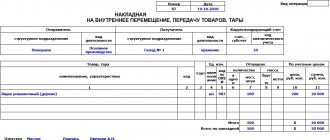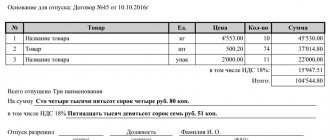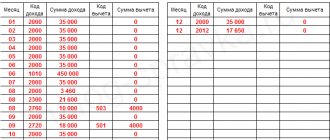What is a demand invoice M-11? In the article we will look at why a document is needed, on what basis it is drawn up, how it is drawn up, and how long it is stored. All sample forms mentioned in the article can be downloaded. The demand invoice (form M-11) is an internal document of the organization - it is not transferred to either the buyer or the supplier. All movements of materials in the organization: between departments, from employee to employee - are accompanied by the execution of this document.
IMPORTANT!
Unified forms of primary accounting documents approved by Resolution of the State Statistics Committee of October 30, 1997 No. 71a are not mandatory, based on the requirements of Law No. 402-FZ. An organization can consolidate the forms of primary accounting documents in its accounting policies. The exception is unified forms that are mandatory for use on the basis of federal laws and regulations.
Unified forms for public sector organizations are defined in Order of the Ministry of Finance dated March 30, 2015 No. 52n, which specifies the form of the demand invoice (OKUD 0504204). This means that public sector organizations must only use Form 0504204.
IMPORTANT!
If the organization provides restrictions on the supply of goods and materials, then for this purpose a form of limit-fence cards M-8 is provided, which can be downloaded at the bottom of the article.
M-11 contains the following information:
- name of goods and materials;
- sender (structural unit or department, OKVED type of activity);
- recipient (structural unit or department, OKVED);
- accounting account (sub-account) (sender, recipient);
- quantity of inventory items;
- price.
Transfer of inventory items can be carried out in the following cases:
- return of balances to the warehouse (unused in the production process of goods and materials);
- return to the warehouse of defective products (production waste);
- issuing materials from the warehouse to the responsible person;
- moving between warehouses, etc.
When is M-11 compiled?
Let's consider the movement of goods within the organization.
Inventory and materials arrive at the warehouse, and the storekeeper draws up a document reflecting the receipt: for example, receipt order M-4 (form according to OKUD 0315003). The data is also reflected in the materials accounting card, for example, in form M-17 (OKUD 0315008) (forms M-4 and M-17 can be downloaded below).
The goods are then stored in the warehouse until shipment. The warehouseman can ship goods to both contractors (suppliers, customers) and internal users (employees, owners, founders).
If there is a need to ship goods within the company, then in this case an M-11 invoice is issued. The basis for issuing a demand invoice is the request for material assets located in the warehouse.
The invoice should be printed in three copies:
- one is kept by the sender;
- the second is transferred to the accounting department;
- the third copy is in stock.
Procedure for obtaining form M-11
Form M-11 in 2 copies is drawn up by the person who initiated the receipt of goods at the warehouse or their delivery to the warehouse (transfer to another financially responsible person). With automated warehouse accounting, this document can be generated by the warehouseman in the appropriate program at the time of release from the warehouse or acceptance into it.
Copies of this document serve as the basis for carrying out accounting warehouse operations by departments (materially responsible persons) who are the deliverer and recipient, and after their submission to the accounting department, they are used to reconcile data and make accounting entries for write-offs, transfers or capitalization.
The required details for filling out this document are:
- the name of the organization in which the document was issued and its OKPO code;
- Date of preparation;
- names of departments of the sender and recipient, indicating the types of their activities;
- information (full name) about the person who actually receives (deliveres) the valuables on behalf of the recipient unit (deliverer);
- data (full name) of the person who took the initiative in obtaining the MPZ and the person who authorized this receipt;
- names of materials received or handed over, their units of measurement and the requested (surrendered) quantity;
- signatures of the persons who submitted and received the MPZ.
Data on the item number and the actual quantity issued (received) are entered at the time of release (reception) at the warehouse.
Information about the necessary accounting accounts and the accounting value of inventories is filled out in the accounting department according to accounting records.
The demand invoice form in form M-11, which is a unified document approved by the State Statistics Committee, is not absolutely mandatory for use. Each organization can develop its own form of a primary document of a similar purpose independently, enshrining it in its accounting policies.
Read more about organizing warehouse accounting in the article “Methods of maintaining warehouse accounting of goods (nuances)” .
Details and filling procedure
Let's consider the procedure for filling out M-11. The invoice is drawn up by the employee of the department where the inventory items are stored and indicates:
- date of compilation;
- structural units of the sender and recipient;
- data on inventory items (name, item number, unit of measurement, quantity);
- if a transaction coding system is used, the corresponding code.
Data on inventory items can also be filled in by the person responsible for production.
The document is internal, therefore it is signed only by the employees responsible for the operation - materially responsible persons (hereinafter - MOL). The warehouse employee checks that the signature of the recipient or transmitter, as well as the person through whom the transfer is made, is present. MOLs must indicate their full name and position.
After this, the accountant fills out the “corresponding account” column and indicates the cost indicators of inventory items.
Request invoice, form 0504204, sample filling
When is a standard interindustry form M-11 needed?
Using the requirement-invoice form M-11 (a unified document approved by Decree of the State Statistics Committee of the Russian Federation dated October 30, 1997 No. 71a), the internal transfer of inventories is drawn up, i.e. the procedure:
- releases from the warehouse for production needs;
- movement between warehouses or financially responsible persons;
- return of unused inventories to the warehouse;
- delivery of finished products, returnable waste, defects, as well as materials generated during the liquidation of OS to the warehouse.
What distinguishes the requirement-invoice from a similar document, the limit-fence card (form M-8), is the possibility of using:
- for unlimited supply of materials from the warehouse;
- registration of the transfer of several items of inventories in 1 document;
- each fact of movement of goods.
For more information about the documents used for warehouse accounting, read the article “Maintaining document flow for warehouse accounting of materials .
Invoice storage periods
After processing information from M-11, the accountant must ensure its archiving and storage. You can store the archive not only in the organization, but also in a public or private archive. Since the demand invoice is a primary accounting document, the storage period cannot be less than the period specified in Art. 29 of Law No. 402-FZ - at least 5 years after the reporting year.
IMPORTANT!
Clause 4 art. 283 of the Tax Code of the Russian Federation provides for a longer storage period for documents confirming losses of previous periods.
Requirement invoice M-11: sample filling
You can fill out the document by hand or on the computer. To avoid making mistakes in the form, download a ready-made sample of filling out the M-11 demand invoice and fill in your data.
Get a sample for free!
Register in the online document printing service MoySklad, where you can: completely free of charge:
- Download the sample you are interested in in Excel or Word format
- Fill out and print the document online (this is very convenient)
Be sure to include:
- standard form number M-11,
- name of the organization and its OKPO code,
- date,
- information about the sender and recipient, for example, warehouse or packaging workshop,
- who requested the materials and allowed them to be released,
- names and units of measurement of inventory materials,
- quantity of materials requested and issued.
Indicate only the actual date - materials must be transferred within one business day. If you didn’t have time, fill out a new demand form - invoice form M11.
Be careful: blots and corrections are not allowed in the document. If you make a mistake, you will have to fill out the form again.
In the MoySklad service M-11 and other documents can be filled out online. This is very convenient: you will not make mistakes and save time, because the data will not need to be entered and checked manually.
Responsibility for drawing up and recording the invoice
Despite the fact that this document is internal, it accompanies the movement of values, and the persons who signed it are financially responsible. If something unexpected happens to the property: theft, damage, other loss, then MOL’s liability may even be criminal. Also, on the basis of M-11, warehouse and accounting are carried out. The storekeeper and accountant are responsible for the correct reflection of accounting data. Accounting data is used to carry out inventories and is also part of accounting and tax reporting.
Responsibility for the absence of a document is provided for in Art. 120 Tax Code of the Russian Federation.
Form of limit-fence cards M-8
M 11, demand invoice
Receipt order form M-4
Write-off of materials for business needs in 1C
Let's look at how to create and fill out this document in the 1C:Enterprise program. As an example, let’s take the write-off of materials for administrative purposes of the organization.
To create a document, you need to go to the “Warehouse” menu tab and follow the link to the document log “Requirements-invoices”.
Then click on “Create” and open a new document, which now needs to be filled out correctly.
Next to the “Create” button you can see the “Copy” button. This button can be used if you need to fill out documents that have the same nomenclature (for example, write off gasoline monthly). In this case, you can simply copy the previous document and make the required corrections to it.
In the window that appears, you must fill in the necessary details and, using the “Select” or “Add” command, select the item for transfer or write-off.
Please note that if the checkbox is not checked in the “Cost accounts” column on the “Materials” tab, then write-off accounts will have to be filled out in a separate tab of the document in accordance with the accounting policy of your enterprise.
When selecting an item (the “Selection” command), by selecting an item group in the left part of the window and clicking on the “Only balances” button, in the right area of the window we can see the available balances for the selected warehouse.
If in the “Settings” tab there is a checkmark in the “Request quantity” column, then when you select an item, a dialog box will be displayed in which you indicate the number of units to add to the document. Then, thanks to the “Move to Document” command, they appear in the tabular section.
By clicking on the “Print” button from the document, you can print out the “Demand-invoice” and “Request-invoice (M-11)” forms.
Request-invoice form 0504204: sample filling
Let's look at how to fill out the OKUD 0504204 form using an example. To do this, let’s assume that the institution GBOU DOD SDYUSSHOR “Allur” needed to transfer an electric drill from a warehouse to the administrative and economic department (hereinafter referred to as AHO). The document is drawn up by the storekeeper of warehouse No. 3 in two copies: the first is handed over to the authorized representative of the AHO (along with the drill), the second remains in the warehouse, and later it will be transferred to the accounting department of the institution.
Step 1. The storekeeper of warehouse No. 3 fills out the details of the institution, including its OKPO code, indicates the name of the structural units that are involved in the transfer, and then the number of the demand invoice and the date of the operation. Next, fill in the details “Requested” and “Allowed”, indicating the positions and full names of the responsible persons:
Step 2. Then, in the tabular section, it reflects the name of the transferred goods and materials, item number, passport number (or serial number) of each unit (if any), the number of transferred goods and materials, their price and amount.
The “Total” line displays summarized data for all records specified in the document. The storekeeper, as a financially responsible person, should not fill out columns 10 and 11 here - this information is indicated by the responsible services (including accounting).
Step 3. Finally, the parties enter the details of the employees who are responsible for the transfer of the electric drill, and the date of the event is indicated.
Step 4. Within the established period, the demand invoice is transferred by the storekeeper to the appropriate service of the institution, which processes the received data: indicates the corresponding accounts and makes appropriate entries in the transaction log. After this, fill in the details of the “accounting” part of the document:
Application of the invoice requirement
The document accompanies the movement of goods without any limit. One form may contain several types of assets in the list of transferred products. M-11 is compiled for each movement of stocks or group of material assets to accompany a number of operations:
- Transfer of assets between sites with responsible persons or divisions.
- Release of material and raw materials into production for further processing.
- Return of the balance of inventory previously released on demand and not used in production, as well as identified defective materials.
- Transfer of remaining materials and spare parts arising after the liquidation of the operating system.
- Return of production waste subject to secondary processing.
- Transfer of inventory items to the finished goods warehouse.
- Release of material assets for economic needs, carrying out construction work on an economic basis.
- Issuance of special equipment or inventory with simultaneous deregistration.
Using an invoice request in operations allows you to monitor the movement of inventories, the presence of balances and inventory items, and control the production process. In tax accounting, data on the movement of inventories is used to confirm expenses when calculating income tax and to determine the balances of material assets that are not included in the calculation when calculating the taxable base. Read also the article: → “Accounting for goods and products in a warehouse in 2021.”
Creating a “Request-invoice” document based on another document
1C programs have many different useful functions, one of which is to enter a document based on.
The document that we are considering as an example can be entered according to the “Receipt” document, which was issued earlier. To do this, you need to open the receipt document and click on “Create based on”. Then, from the list that appears, you must select “Request-invoice” and, if necessary, correct this document.
Features and shelf life
Since the demand invoice is a primary accounting document, it must be stored for at least 5 years. Federal law imposes requirements for maintaining the invoice in proper condition . Therefore, it must be stored in a place where it will not be subject to changes, it must be:
- Protected from environmental influences (for example, high humidity).
- Provided with fire protection.
- Available only to a certain circle of people.
The demand invoice is a document of great importance. It is used to keep track of materials at the enterprise. If you draw up the necessary documents in a disciplined manner, you can avoid problems during the audit.
If you find an error, please select a piece of text and press Ctrl+Enter.









